Form FEMA Form FF-104-F FEMA Form FF-104-F Tele-Registration, Disaster Assistance Registration (Eng
Disaster Assistance Registration
Public DisasterAssistance.gov RI 8.1.25_IA Mod Helptext_ with both Income options
Tele-Registration Application for Disaster Assistance (English and Spanish)
OMB: 1660-0002
DisasterAssistance.gov Staging: All Needs Registration with content
Apply Now
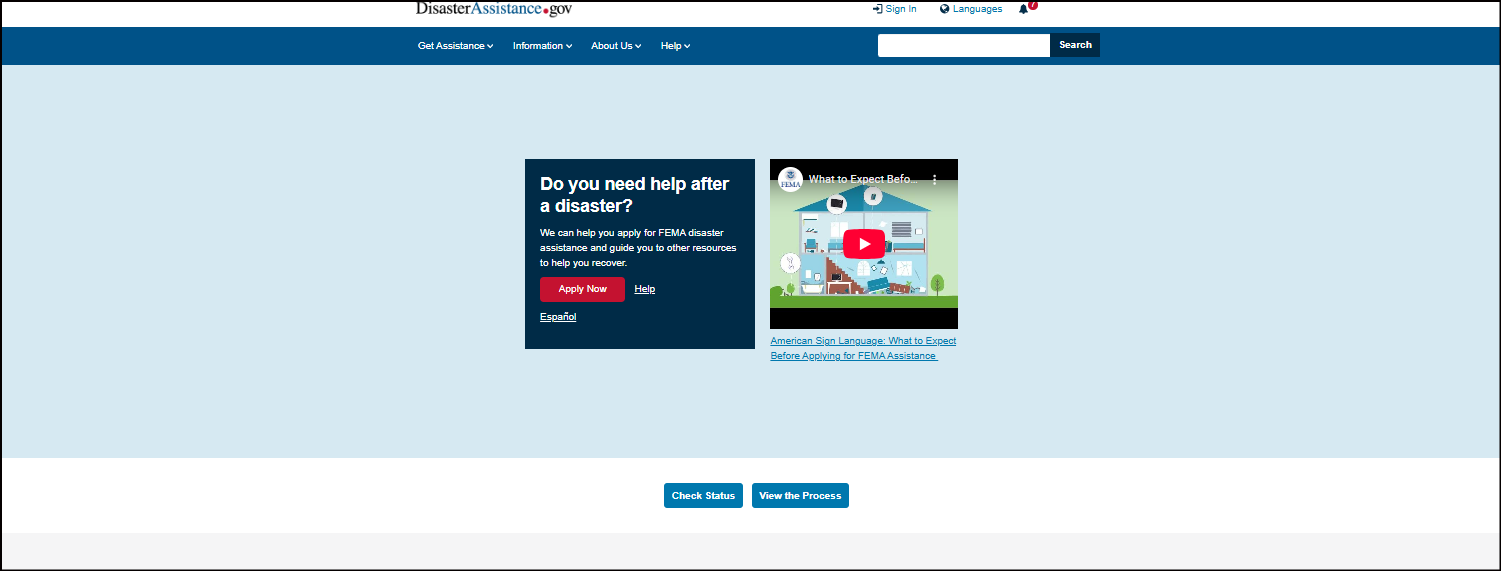
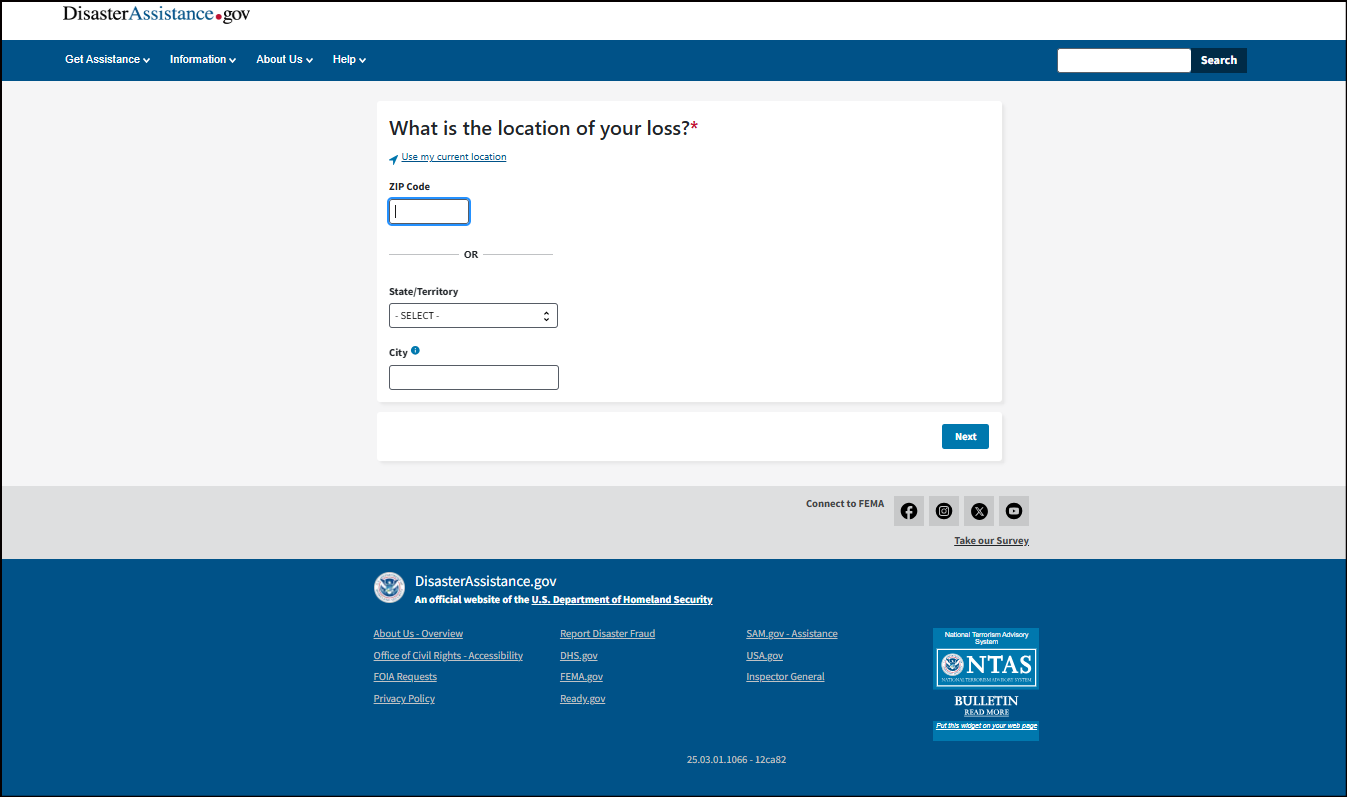
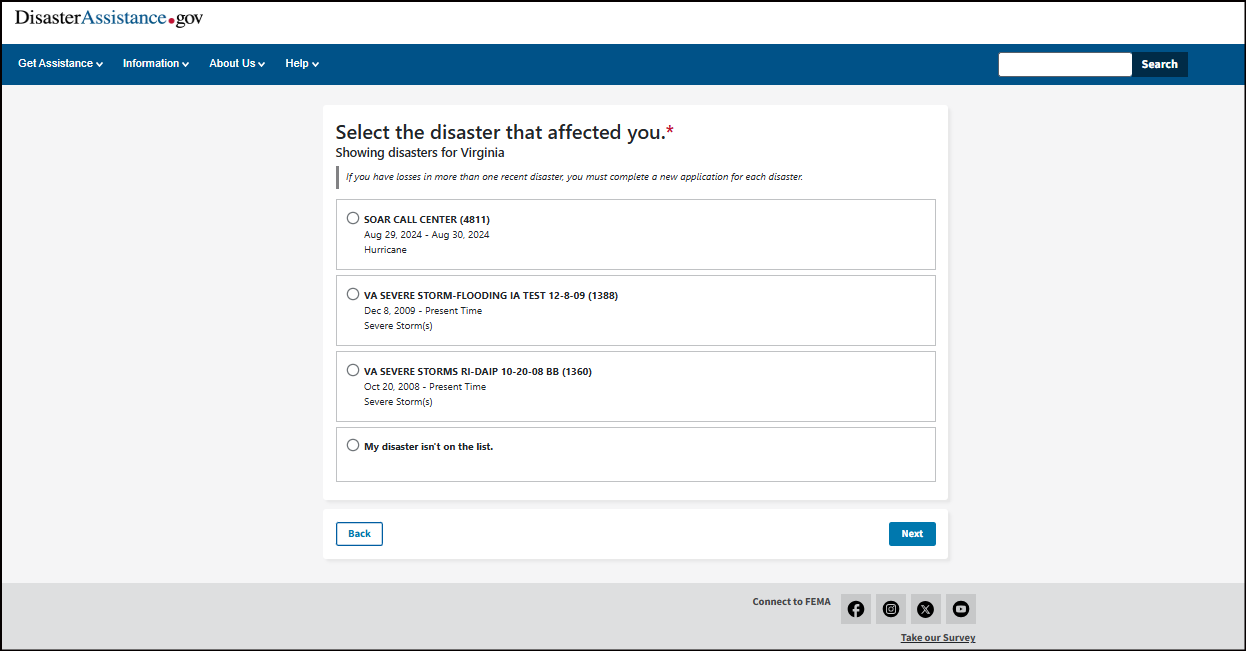
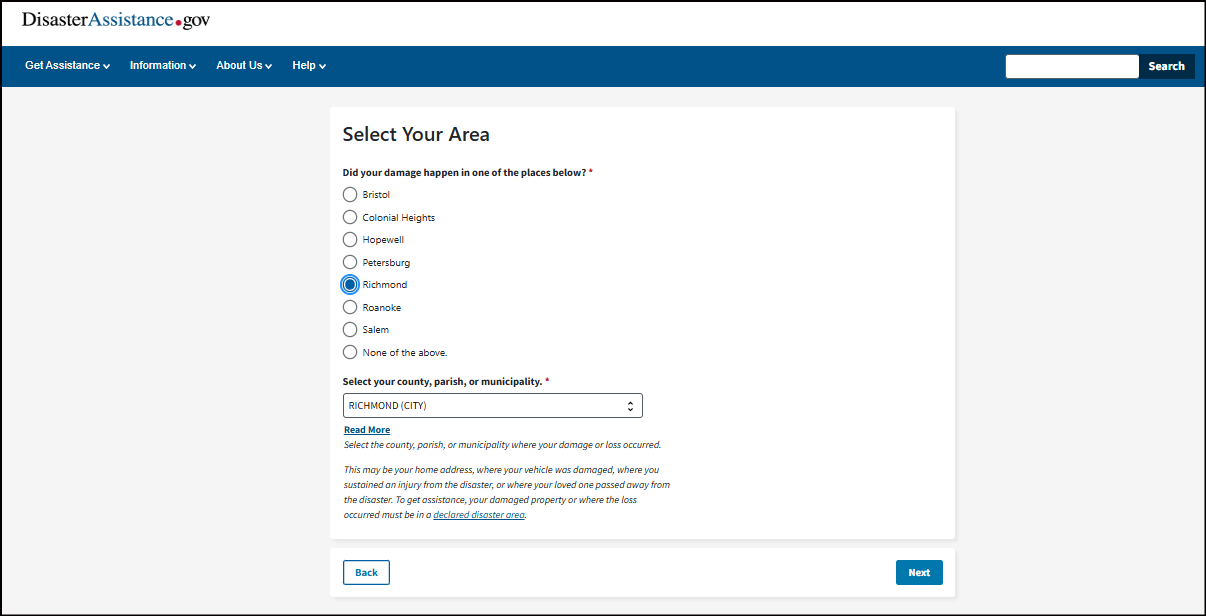
Read More
Select the county, parish, or municipality where your damage or loss occurred.
This may be your home address, where your vehicle was damaged, where you sustained an injury from the disaster, or where your loved one passed away from the disaster. To get assistance, your damaged property or where the loss occurred must be in a declared disaster area.
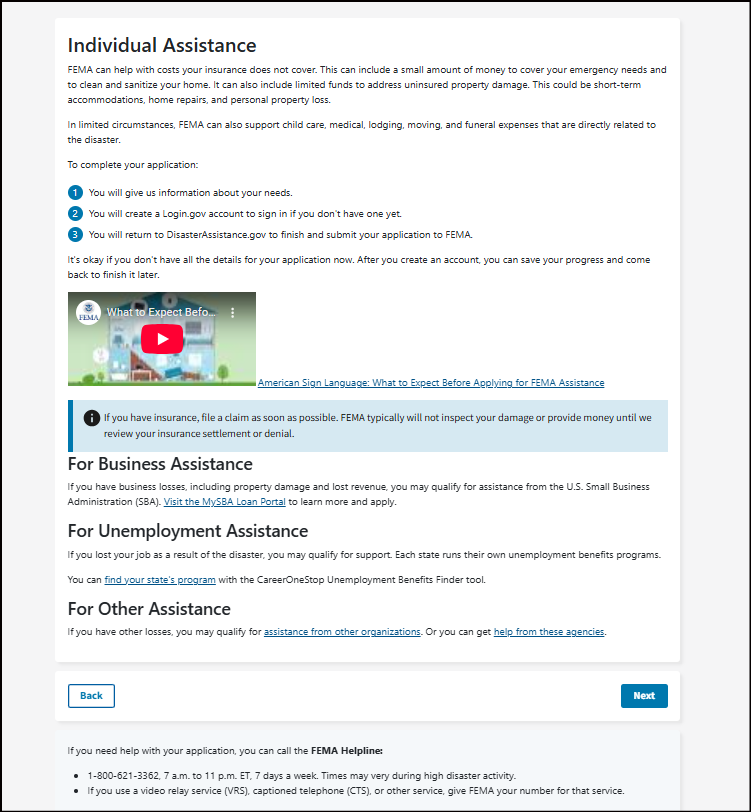
Individual Assistance
FEMA can help with costs your insurance does not cover. This can include a small amount of money to cover your emergency needs and to clean and sanitize your home. It can also include limited funds to address uninsured property damage. This could be short-term accommodations, home repairs, and personal property loss.
In limited circumstances, FEMA can also support child care, medical, lodging, moving, and funeral expenses that are directly related to the disaster.
To complete your application:
You will give us information about your needs.
You will create a Login.gov account to sign in if you don't have one yet.
You will return to DisasterAssistance.gov to finish and submit your application to FEMA.
It's okay if you don't have all the details for your application now. After you create an account, you can save your progress and come back to finish it later.
[Embedded Video]
If you have insurance, file a claim as soon as possible. FEMA typically will not inspect your damage or provide money until we review your insurance settlement or denial.
For Business Assistance
If you have business losses, including property damage and lost revenue, you may qualify for assistance from the U.S. Small Business Administration (SBA). Visit the MySBA Loan Portal to learn more and apply.
For Unemployment Assistance
If you lost your job as a result of the disaster, you may qualify for support. Each state runs their own unemployment benefits programs.
You can find your state's program with the CareerOneStop Unemployment Benefits Finder tool.
For Other Assistance
If you have other losses, you may qualify for assistance from other organizations. Or you can get help from these agencies.

Select Your Disaster-related Needs
Check all that apply.
FEMA offers different types of assistance depending on your specific needs. Letting us know your needs helps us determine what assistance you may be eligible for. We use this information to categorize your needs into our assistance types.
*Note: You don't need to have everything listed in each option. If even part of one choice fits your situation, choose it. If you do not check an option but later have that need, call FEMA or visit a Disaster Recovery Center to update your application.
Property Damage
Home damage
Read More
FEMA may help if your home was damaged by the disaster regardless of whether you rent or own your home.
This may include temporary housing or repair costs that your insurance does not cover. Only your primary home is eligible, which you live in most of the year. FEMA may ask for a copy of your receipts or estimates for home repair costs.
FEMA Assistance is limited. The amount of money FEMA may give is based on your confirmed damage. In 2024, eligible households received an average of $6,800 in Home Repair Assistance.
Vehicle damage
Read More
FEMA may help if your vehicle or vehicles were damaged by the disaster and not covered by insurance.
Vehicles, like your car, truck, motorcycle, or van, must be equipped and licensed for use on public roads. They must also comply with state registration and insurance requirements. FEMA may ask for a copy of your mechanic receipts or estimates for your damaged vehicle.
FEMA Assistance is limited. The amount of money FEMA may give is based on the amount set by your state. In 2024, eligible households received an average of $3,120 in Transportation Assistance.
Personal Property damage
Read More
FEMA may help with household items that are damaged by the disaster and not covered by insurance. This includes things like appliances, clothing, furniture, computers, items needed for work or school, and accessibility items.
FEMA may ask for a copy of your receipts or estimates for property costs.
FEMA Assistance is limited. The amount of money FEMA may give is based on your confirmed damage. In 2024, eligible households received an average of $1,970 in Personal Property Assistance.
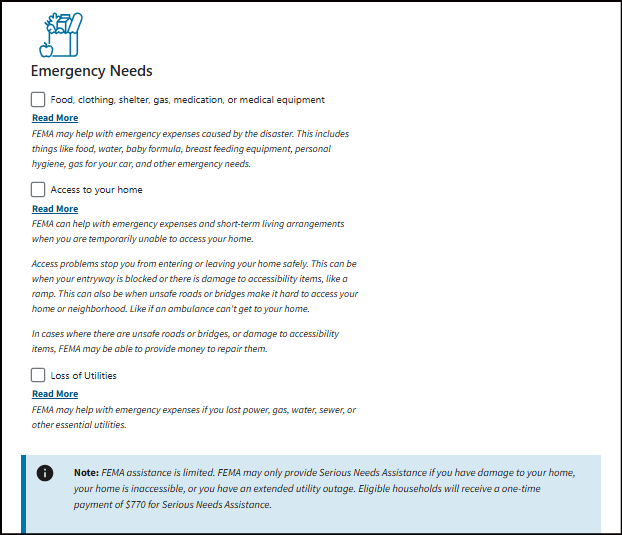
Emergency Needs
Food, clothing, shelter, gas, medication, or medical equipment
Read More
FEMA may help with emergency expenses caused by the disaster. This includes things like food, water, baby formula, breast feeding equipment, personal hygiene, gas for your car, and other emergency needs.
Access to your home
Read More
FEMA can help with emergency expenses and short-term living arrangements when you are temporarily unable to access your home.
Access problems stop you from entering or leaving your home safely. This can be when your entryway is blocked or there is damage to accessibility items, like a ramp. This can also be when unsafe roads or bridges make it hard to access your home or neighborhood. Like if an ambulance can't get to your home.
In cases where there are unsafe roads or bridges, or damage to accessibility items, FEMA may be able to provide money to repair them.
Loss of Utilities
Read More
FEMA may help with emergency expenses if you lost power, gas, water, sewer, or other essential utilities.
Note: FEMA assistance is limited. FEMA may only provide Serious Needs Assistance if you have damage to your home, your home is inaccessible, or you have an extended utility outage. Eligible households will receive a one-time payment of $770 for Serious Needs Assistance.

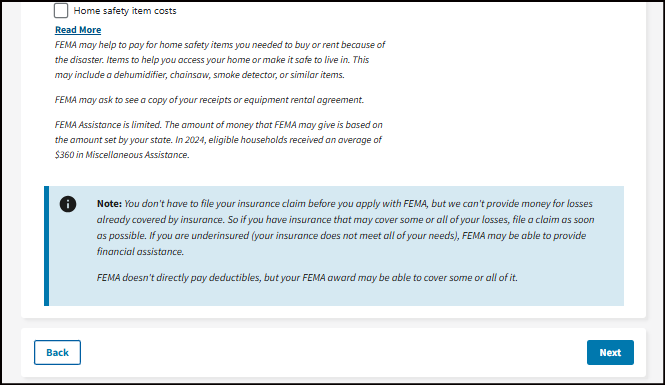
Other Expenses
Funeral or reburial expenses
Read More
FEMA may help with funeral expenses, like burial, cremation, and funeral services, that are not covered by insurance. FEMA can't help with funeral or reburial costs for pets.
FEMA may ask for a copy of your receipts or estimates for funeral costs.
FEMA Assistance is limited. The amount of money that FEMA may give is based on the amount set by your state. In 2024, eligible households received an average of $5,100 in Funeral Assistance.
Lodging expenses
Read More
FEMA may help with lodging expenses (room and taxes) that are not covered by insurance. You must not have been able to stay in your home due to the disaster.
FEMA may ask for a copy of your lodging receipts.
FEMA Assistance is limited. The amount of money that FEMA may give is based on your needs. In 2024, eligible households received an average of $800 for lodging expenses.
Medical or dental expenses
Read More
FEMA may help with medical and dental expenses caused by the disaster that are not covered by insurance. This may include replacing prescribed medication; personal medical or dental equipment; out-of-pocket costs for an injury or loss caused by the disaster; and costs for the loss or injury of a service animal.
FEMA may ask to see a copy of your receipts or estimates for medical and dental costs.
FEMA assistance is limited. The amount of money that FEMA may give is based on your needs. In 2024, eligible households received an average of $2,000 in Medical Assistance and an average of $4,700 in Dental Assistance.
New or extra child care costs
Read More
FEMA may help with a limited amount of new or extra child care costs after the disaster. Costs from providers licensed in your state. This may include registration or other fees and the increased cost of child care services for children 13 and under (age 21 and under for children with a disability).
Child care services include any personal assistance services used to support the daily living activities of children with disabilities.
FEMA may ask for a copy of your receipts or estimates for child care costs.
FEMA assistance is limited. The amount of money that FEMA may give is based on the amount set by your state. In 2024, eligible households received an average of $940 in Child Care Assistance.
Home safety item costs
Read More
FEMA may help to pay for home safety items you needed to buy or rent because of the disaster. Items to help you access your home or make it safe to live in. This may include a dehumidifier, chainsaw, smoke detector, or similar items.
FEMA may ask to see a copy of your receipts or equipment rental agreement.

Note: You don't have to file your insurance claim before you apply with FEMA, but we can't provide money for losses already covered by insurance. So if you have insurance that may cover some or all of your losses, file a claim as soon as possible. If you are underinsured (your insurance does not meet all of your needs), FEMA may be able to provide financial assistance.
FEMA doesn't directly pay deductibles, but your FEMA award may be able to cover some or all of it.
FEMA Assistance is limited. The amount of money that FEMA may give is based on the amount set by your state. In 2024, eligible households received an average of $360 in Miscellaneous Assistance.
Other Expenses
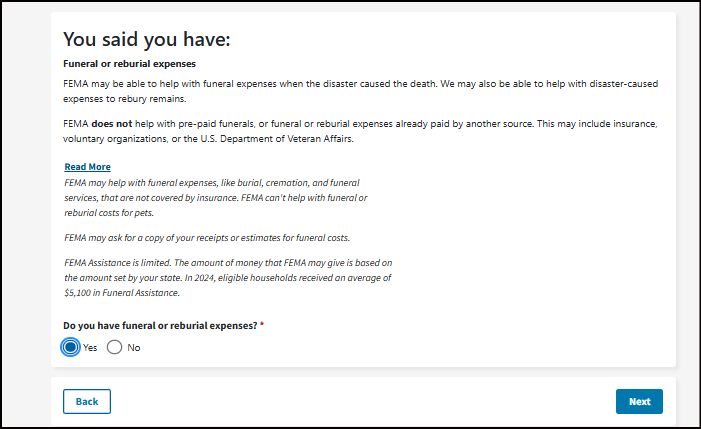
You said you have:
Funeral or reburial expenses
FEMA may be able to help with funeral expenses when the disaster caused the death. We may also be able to help with disaster-caused expenses to rebury remains.
FEMA does not help with pre-paid funerals, or funeral or reburial expenses already paid by another source. This may include insurance, voluntary organizations, or the U.S. Department of Veteran Affairs.
Read More
FEMA may help with funeral expenses, like burial, cremation, and funeral services, that are not covered by insurance. FEMA can't help with funeral or reburial costs for pets.
FEMA may ask for a copy of your receipts or estimates for funeral costs.
FEMA Assistance is limited. The amount of money that FEMA may give is based on the amount set by your state. In 2024, eligible households received an average of $5,100 in Funeral Assistance.
Do you have funeral or reburial expenses? *
Yes/No
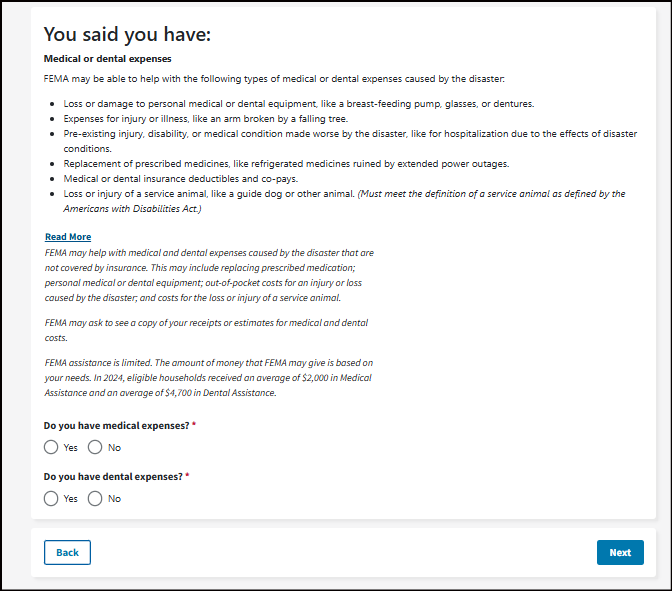
You said you have:
Medical or dental expenses
FEMA may be able to help with the following types of medical or dental expenses caused by the disaster:
Loss or damage to personal medical or dental equipment, like a breast-feeding pump, glasses, or dentures.
Expenses for injury or illness, like an arm broken by a falling tree.
Pre-existing injury, disability, or medical condition made worse by the disaster, like for hospitalization due to the effects of disaster conditions.
Replacement of prescribed medicines, like refrigerated medicines ruined by extended power outages.
Medical or dental insurance deductibles and co-pays.
Loss or injury of a service animal, like a guide dog or other animal. (Must meet the definition of a service animal as defined by the Americans with Disabilities Act.)
Read More
FEMA may help with medical and dental expenses caused by the disaster that are not covered by insurance. This may include replacing prescribed medication; personal medical or dental equipment; out-of-pocket costs for an injury or loss caused by the disaster; and costs for the loss or injury of a service animal.
FEMA may ask to see a copy of your receipts or estimates for medical and dental costs.
FEMA assistance is limited. The amount of money that FEMA may give is based on your needs. In 2024, eligible households received an average of $2,000 in Medical Assistance and an average of $4,700 in Dental Assistance.
Do you have medical expenses? *
Yes/No
Do you have dental expenses? *
Yes/No
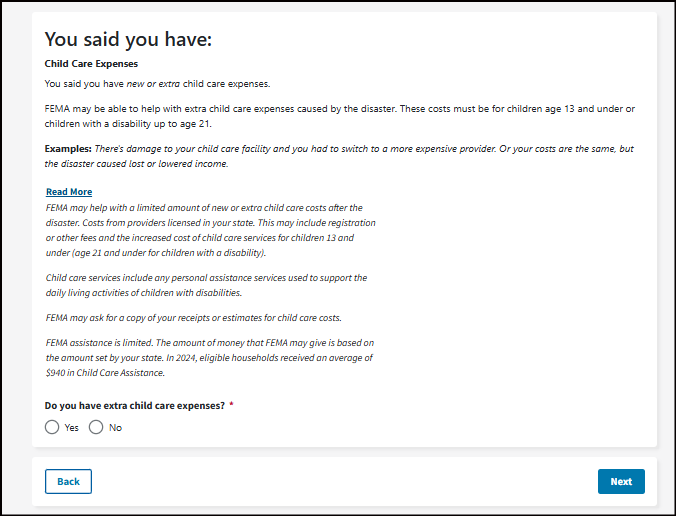
You said you have:
Child Care Expenses
You said you have new or extra child care expenses.
FEMA may be able to help with extra child care expenses caused by the disaster. These costs must be for children age 13 and under or children with a disability up to age 21.
Examples: There's damage to your child care facility and you had to switch to a more expensive provider. Or your costs are the same, but the disaster caused lost or lowered income.
Read More
FEMA may help with a limited amount of new or extra child care costs after the disaster. Costs from providers licensed in your state. This may include registration or other fees and the increased cost of child care services for children 13 and under (age 21 and under for children with a disability).
Child care services include any personal assistance services used to support the daily living activities of children with disabilities.
FEMA may ask for a copy of your receipts or estimates for child care costs.
FEMA assistance is limited. The amount of money that FEMA may give is based on the amount set by your state. In 2024, eligible households received an average of $940 in Child Care Assistance.
Do you have extra child care expenses? *
Yes/No

You said you have:
Home safety item costs
FEMA may be able to help with expenses to buy or rent certain items to help make your home safe after a disaster. Your state, territory, or tribe chooses the list of eligible items.
The list usually includes items like a dehumidifier or a chainsaw to clear a downed tree blocking access to your home.
Other examples: Smoke detectors, carbon monoxide detectors, and generators. Generators usually only qualify if you need to power a medically required device, like a refrigerator for insulin.
Read More
FEMA may help to pay for home safety items you needed to buy or rent because of the disaster. Items to help you access your home or make it safe to live in. This may include a dehumidifier, chainsaw, smoke detector, or similar items.
FEMA may ask to see a copy of your receipts or equipment rental agreement.
FEMA assistance is limited. The amount of money that FEMA may give is based on the amount set by your state. In 2024, eligible households received an average of $360 in Miscellaneous Assistance.
Have you or do you need to buy or rent these types of items? *
Yes/No
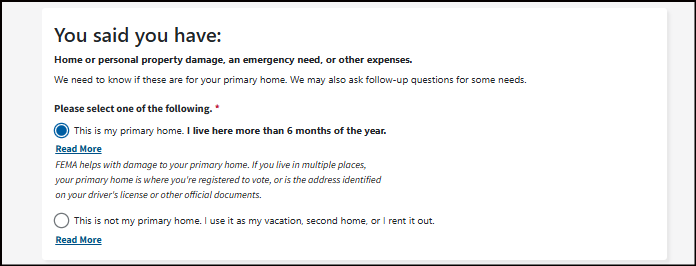
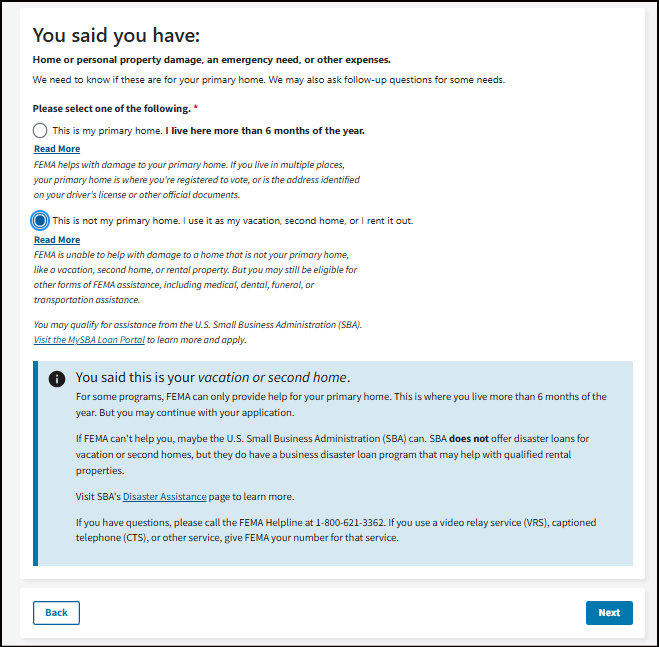
You said you have:
Home or personal property damage, an emergency need, or other expenses.
We need to know if these are for your primary home. We may also ask follow-up questions for some needs.
Please select one of the following. *
This is my primary home. I live here more than 6 months of the year.
Read More
FEMA helps with damage to your primary home. If you live in multiple places, your primary home is where you're registered to vote, or is the address identified on your driver's license or other official documents.
This is not my primary home. I use it as my vacation, second home, or I rent it out.
Read More
FEMA is unable to help with damage to a home that is not your primary home, like a vacation, second home, or rental property. But you may still be eligible for other forms of FEMA assistance, including medical, dental, funeral, or transportation assistance.
You may qualify for assistance from the U.S. Small Business Administration (SBA). Visit the MySBA Loan Portal to learn more and apply.
You said this is your vacation or second home.
For some programs, FEMA can only provide help for your primary home. This is where you live more than 6 months of the year. But you may continue with your application.
If FEMA can't help you, maybe the U.S. Small Business Administration (SBA) can. SBA does not offer disaster loans for vacation or second homes, but they do have a business disaster loan program that may help with qualified rental properties.
Visit SBA's Disaster Assistance page to learn more.
If you have questions, please call the FEMA Helpline at 1-800-621-3362. If you use a video relay service (VRS), captioned telephone (CTS), or other service, give FEMA your number for that service.
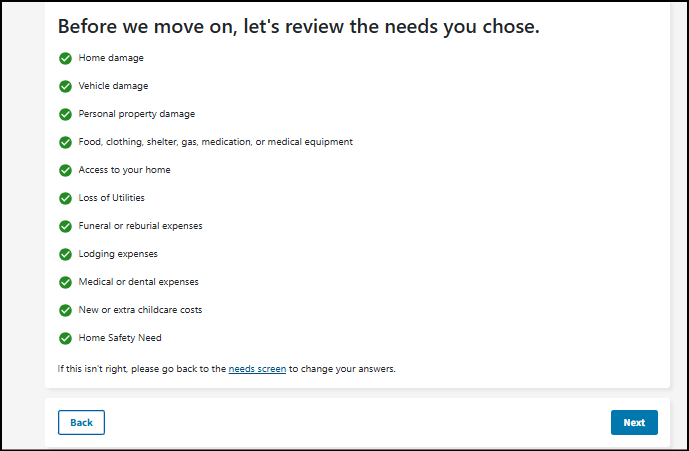
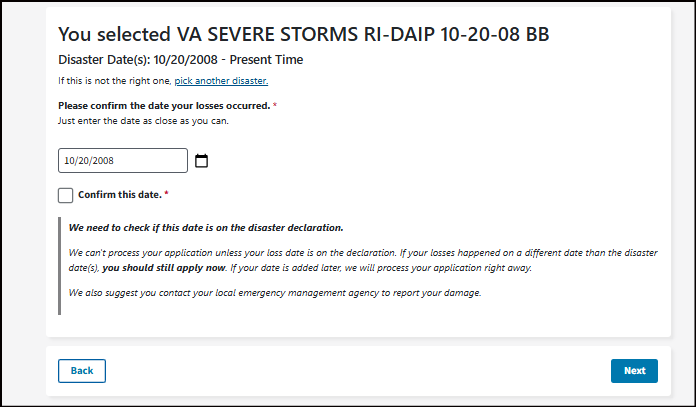
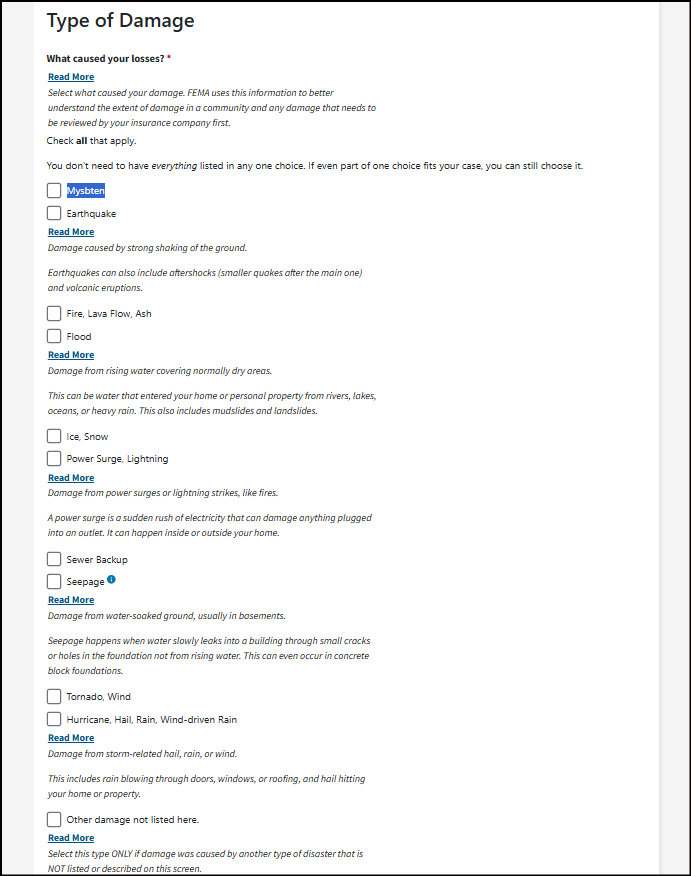
Type of Damage
What caused your losses? *
Read More
Select what caused your damage. FEMA uses this information to better understand the extent of damage in a community and any damage that needs to be reviewed by your insurance company first.
Check all that apply.
You don't need to have everything listed in any one choice. If even part of one choice fits your case, you can still choose it.
Earthquake
Read More
Damage caused by strong shaking of the ground.
Earthquakes can also include aftershocks (smaller quakes after the main one) and volcanic eruptions.
Fire, Lava Flow, Ash
Flood
Read More
Damage from rising water covering normally dry areas.
This can be water that entered your home or personal property from rivers, lakes, oceans, or heavy rain. This also includes mudslides and landslides.
Ice, Snow
Power Surge, Lightning
Read More
Damage from power surges or lightning strikes, like fires.
A power surge is a sudden rush of electricity that can damage anything plugged into an outlet. It can happen inside or outside your home.
Sewer Backup
Seepage
Read More
Damage from water-soaked ground, usually in basements.
Seepage happens when water slowly leaks into a building through small cracks or holes in the foundation not from rising water. This can even occur in concrete block foundations.
Tornado, Wind
Hurricane, Hail, Rain, Wind-driven Rain
Read More
Damage from storm-related hail, rain, or wind.
This includes rain blowing through doors, windows, or roofing, and hail hitting your home or property.
Other damage not listed here.
Read More
Select this type ONLY if damage was caused by another type of disaster that is NOT listed or described on this screen.
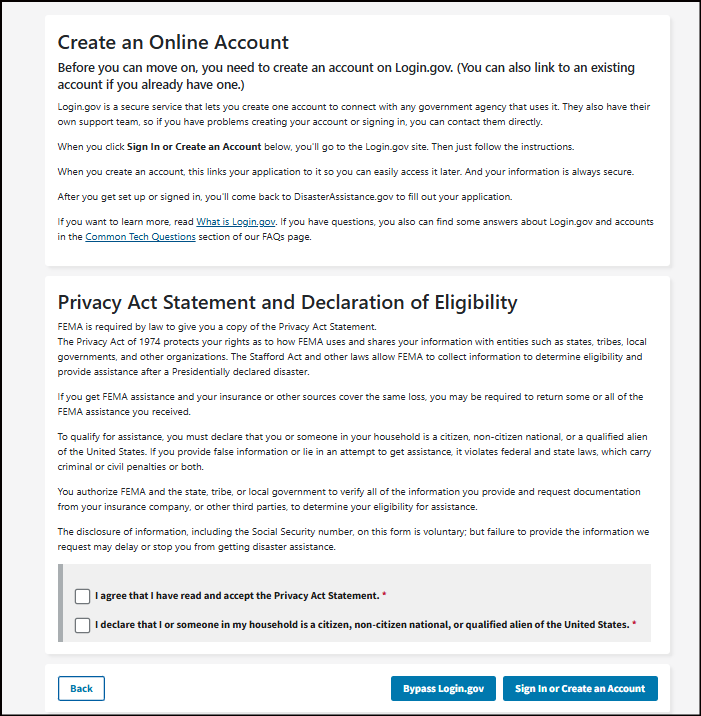

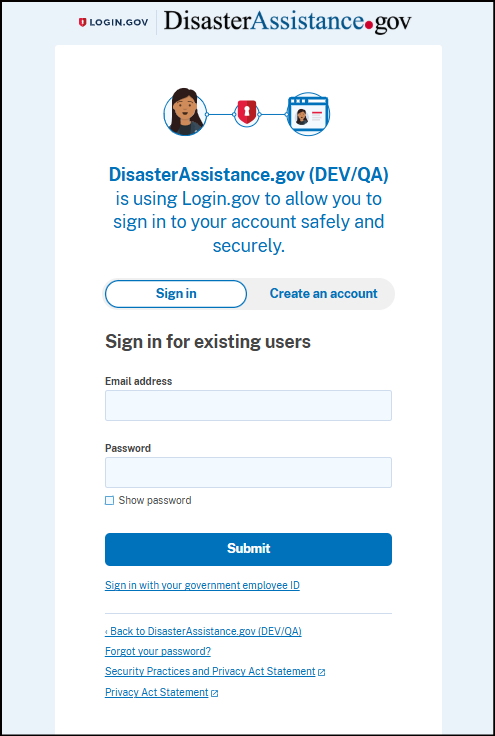

Not in use yet/Income question planned removal
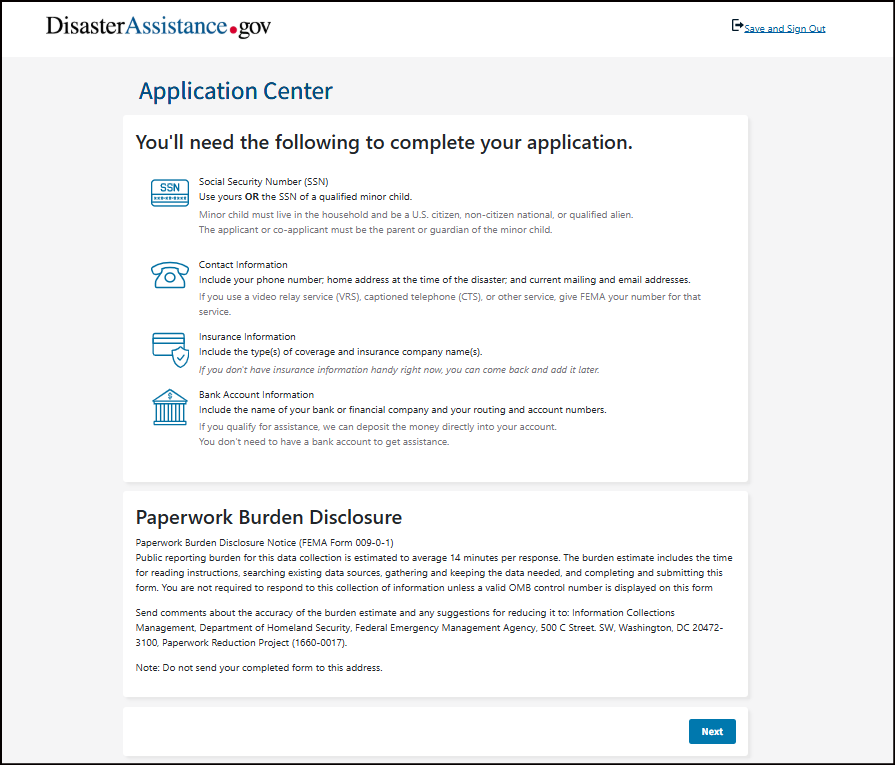
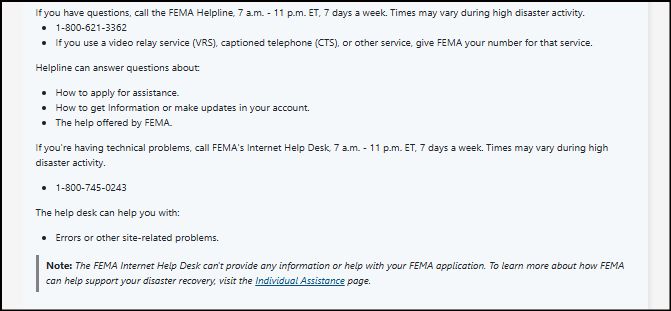
Application Center
You'll need the following to complete your application.
Social
Security Number (SSN)
Use yours OR the SSN
of a qualified minor child.
Minor child must live in the household and be a U.S. citizen, non-citizen national, or qualified alien.
The applicant or co-applicant must be the parent or guardian of the minor child.
Contact
Information
Include your phone number; home address at the
time of the disaster; and current mailing and email addresses.
If you use a video relay service (VRS), captioned telephone (CTS), or other service, give FEMA your number for that service.
Insurance
Information
Include the type(s) of coverage and insurance
company name(s).
If you don't have insurance information handy right now, you can come back and add it later.
Bank Account
Information
Include the name of your bank or financial
company and your routing and account numbers.
If you qualify for assistance, we can deposit the money directly into your account.
You don't need to have a bank account to get assistance.
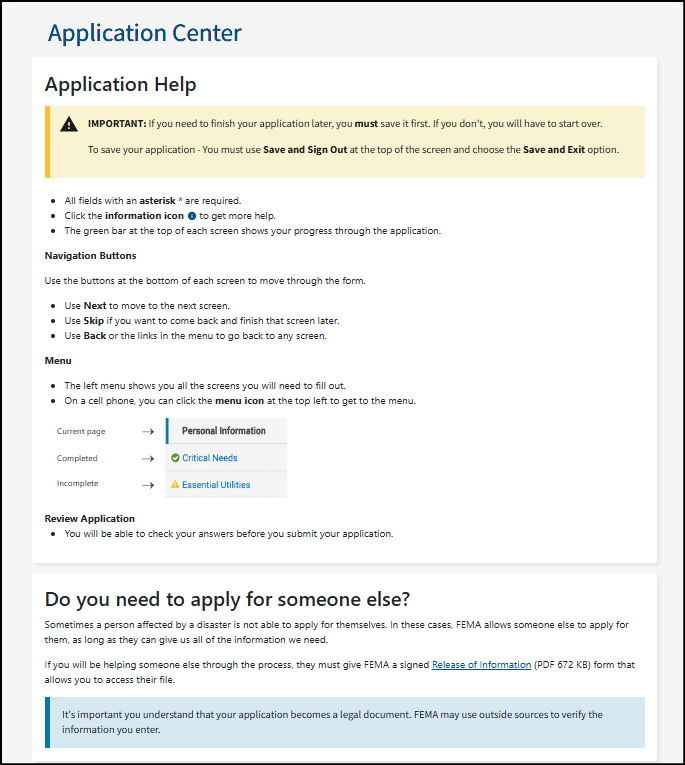



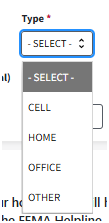

Personal Information
Let's get your personal details now.
To qualify for FEMA Assistance, the person named here as the applicant must be a U.S. citizen, non-citizen national, or qualified alien. If you need to apply under a qualified minor child who lives in your household, you must enter the child's information as the applicant.
[ FORM FIELDS]
Co-Applicant
This person must live in your home. They will have full access to ask for or update information on the application when they call the FEMA Helpline. They will not be able to access the online account.
Note: You must list a parent or guardian as the co-applicant when you apply under a qualified minor child.
Do you want to add a co-applicant? *
Yes/No
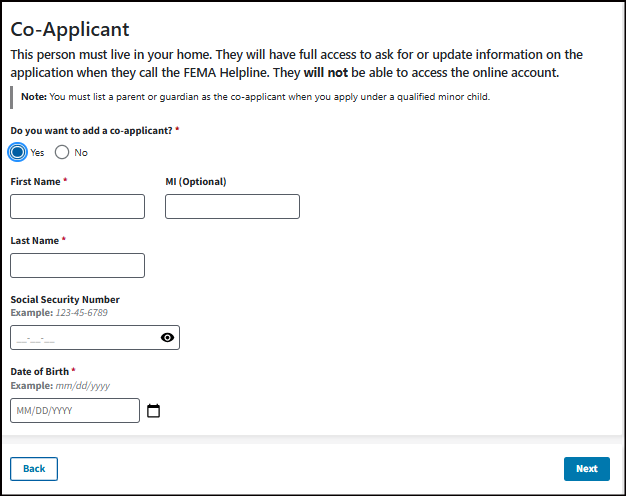

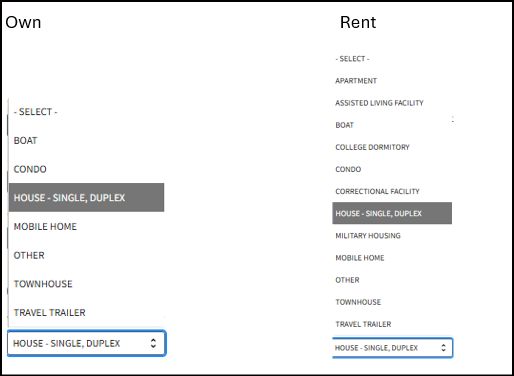
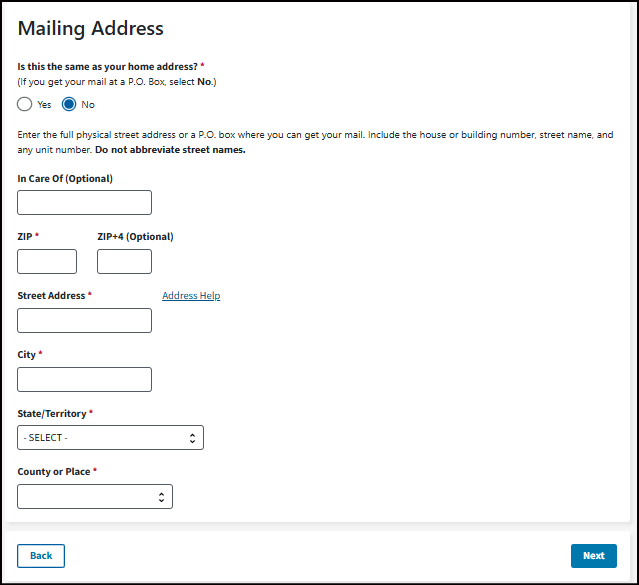
Address Help
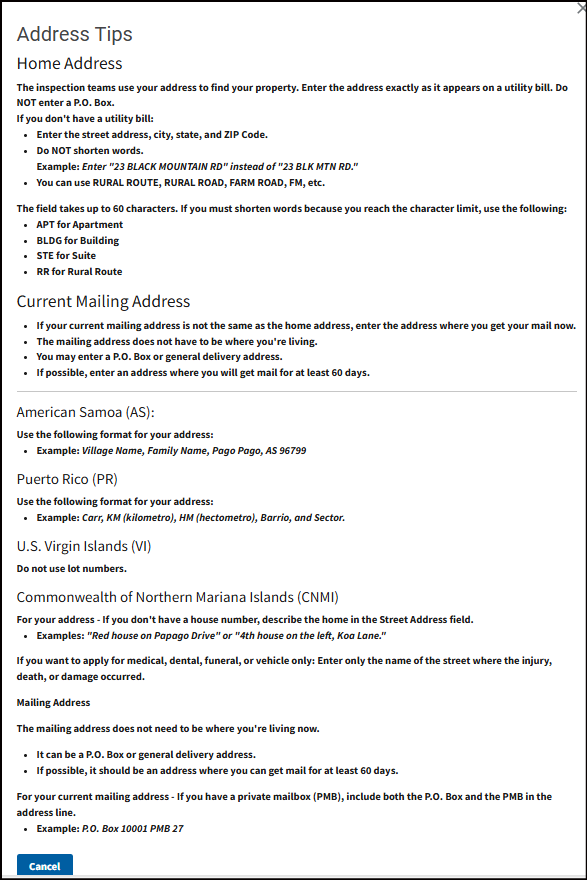
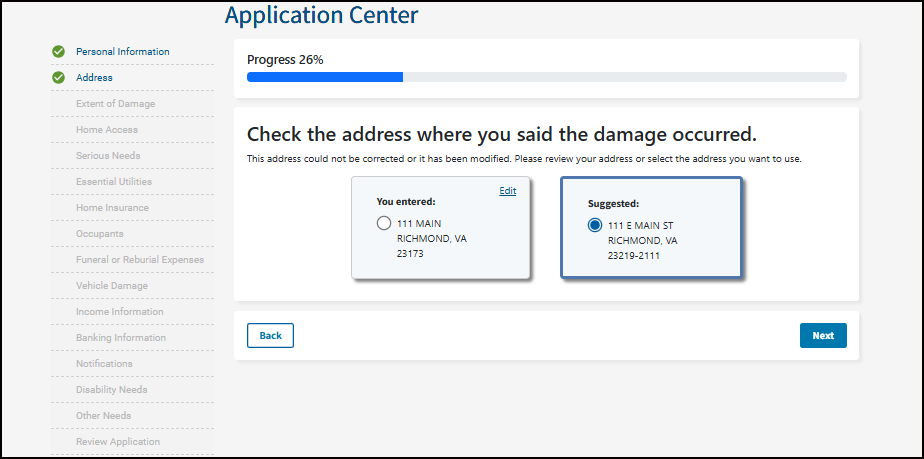
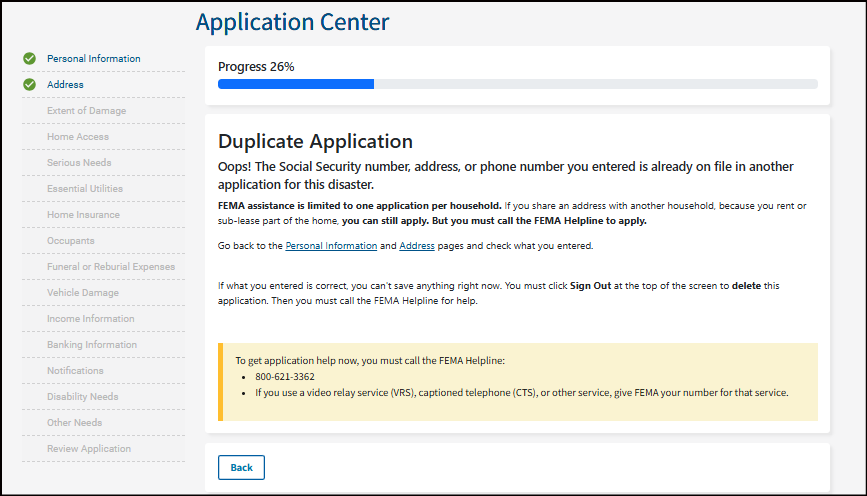
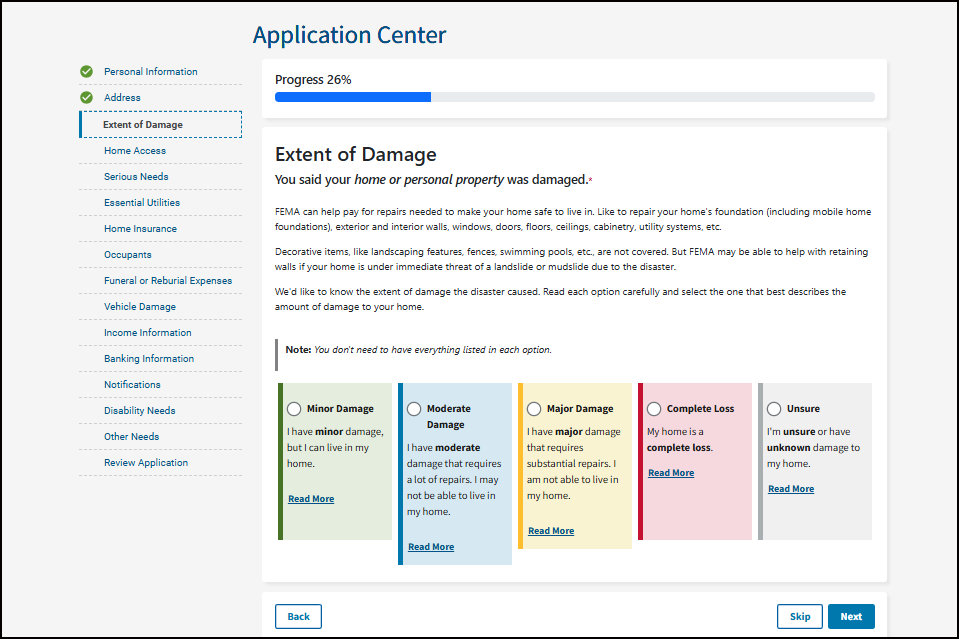
Expanded “Read More”

Extent of Damage
You said your home or personal property was damaged.
FEMA can help pay for repairs needed to make your home safe to live in. Like to repair your home's foundation (including mobile home foundations), exterior and interior walls, windows, doors, floors, ceilings, cabinetry, utility systems, etc.
Decorative items, like landscaping features, fences, swimming pools, etc., are not covered. But FEMA may be able to help with retaining walls if your home is under immediate threat of a landslide or mudslide due to the disaster.
We'd like to know the extent of damage the disaster caused. Read each option carefully and select the one that best describes the amount of damage to your home.
Note: You don't need to have everything listed in each option.
Minor Damage I have minor damage, but I can live in my home.
Read More
Examples of minor damage:
Some damage to or missing siding, roof shingles, gutters, etc.
Some cracked or broken windows.
Minor hairline cracks in floor, walls, or ceilings.
Minor flood water or sewer backup inside the home that goes up to your ankle.
Moderate Damage I have moderate damage that requires a lot of repairs. I may not be able to live in my home.
Read More
Examples of moderate damage:
Flood water inside the home that covers your electrical outlets.
Damage to roof causing damage inside the home.
Damage at multiple places to exterior doors, windows, or siding.
Damage to foundation or walls, like cracks that are as wide as an eraser at the end of a pencil.
Damage to well, septic, or HVAC (central air and heat).
Damage to accessibility aids (like lift, ramp, etc.), preventing safe access.
Debris or overhanging trees that prevents safe access.
Damage to or loss of some household appliances or furnishings.
Major Damage I have major damage that requires substantial repairs. I am not able to live in my home.
Read More
Examples of major damage:
Flood water inside the home that covers your countertops.
Damage to roof, ceilings, walls, or foundation, like cracks that are as wide as a thumb.
Damage to private road or bridge that prevents access.
Immediate threat to the home's stability from landslide or erosion.
Loss of most or all appliances and furnishings.
Unsafe to live in until home repairs completed.
Complete Loss My home is a complete loss.
Read More
Examples of complete damage:
Leveled or completely collapsed.
Washed away.
Burned to the ground.
Beyond repair.
Unsure I'm unsure or have unknown damage to my home.
Read More
Examples of unknown damage:
You're unsure which of these options best describes your damage.
You can't get to or access your home to see the damage.
You left your home under mandatory evacuation, so you don't know the damage.
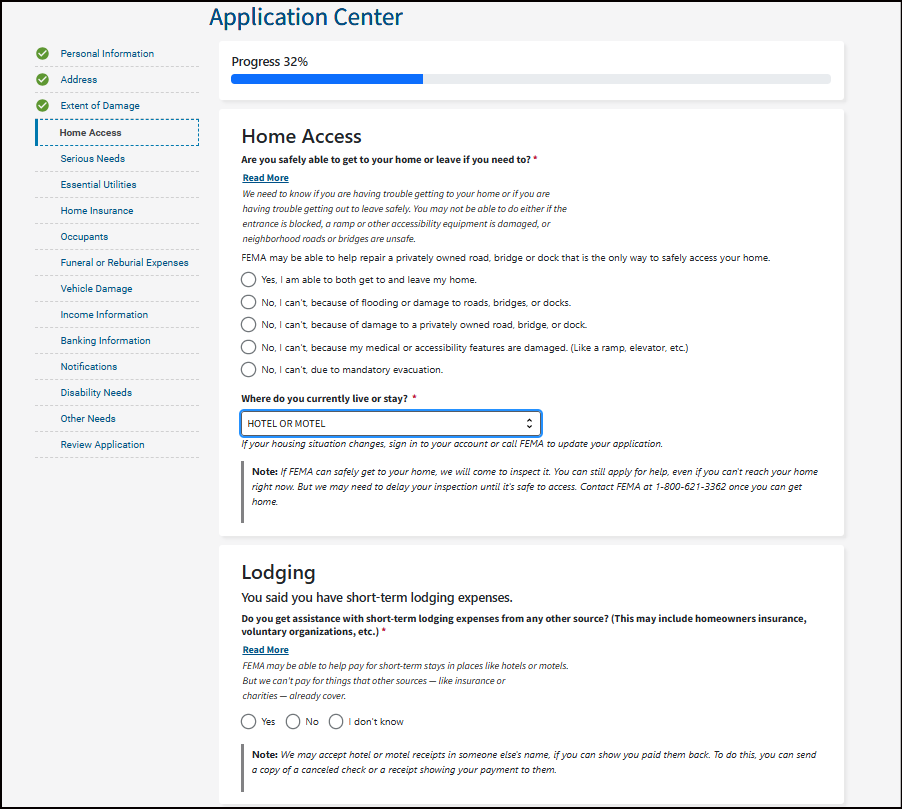
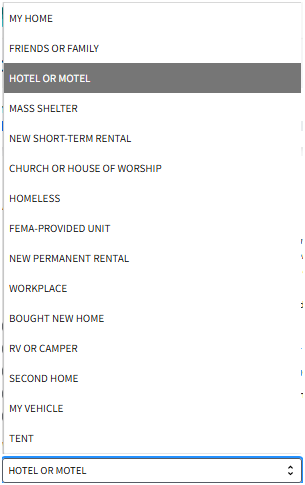
Home Access
Are you safely able to get to your home or leave if you need to? *
Read More
We need to know if you are having trouble getting to your home or if you are having trouble getting out to leave safely. You may not be able to do either if the entrance is blocked, a ramp or other accessibility equipment is damaged, or neighborhood roads or bridges are unsafe.
FEMA may be able to help repair a privately owned road, bridge or dock that is the only way to safely access your home.
Yes, I am able to both get to and leave my home.
No, I can't, because of flooding or damage to roads, bridges, or docks.
No, I can't, because of damage to a privately owned road, bridge, or dock.
No, I can't, because my medical or accessibility features are damaged. (Like a ramp, elevator, etc.)
No, I can't, due to mandatory evacuation.
Where do you currently live or stay? *
[DROPDOWN LIST]
If your housing situation changes, sign in to your account or call FEMA to update your application.
Note: If FEMA can safely get to your home, we will come to inspect it. You can still apply for help, even if you can't reach your home right now. But we may need to delay your inspection until it's safe to access. Contact FEMA at 1-800-621-3362 once you can get home.

Lodging
You said you have short-term lodging expenses.
Do you get assistance with short-term lodging expenses from any other source? (This may include homeowners insurance, voluntary organizations, etc.) *
Read More
FEMA may be able to help pay for short-term stays in places like hotels or motels. But we can't pay for things that other sources — like insurance or charities — already cover.
Yes/No/I don't know
Note: We may accept hotel or motel receipts in someone else's name, if you can show you paid them back. To do this, you can send a copy of a canceled check or a receipt showing your payment to them.
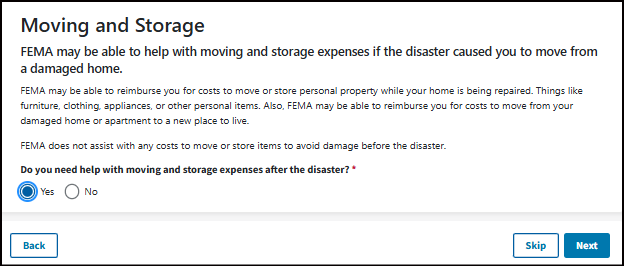
Moving and Storage
FEMA may be able to help with moving and storage expenses if the disaster caused you to move from a damaged home.
FEMA may be able to reimburse you for costs to move or store personal property while your home is being repaired. Things like furniture, clothing, appliances, or other personal items. Also, FEMA may be able to reimburse you for costs to move from your damaged home or apartment to a new place to live.
FEMA does not assist with any costs to move or store items to avoid damage before the disaster.
Do you need help with moving and storage expenses after the disaster? *
Yes/No

Serious Needs
Do you need money to help with any of the following serious needs? *
Select the serious needs that you have as a result of the disaster, like if you need water to drink, your medication was lost or destroyed, you evacuated and need to buy diapers or a toothbrush and toothpaste.
FEMA generally doesn't cover costs to replace stored food if your home isn't damaged by the disaster. For example, when loss of power is the only impact.
Check all that apply.
Yes, I need supplies, like water, food, first aid, or gas.
Yes, I need shelter, because my home is unsafe or I can't access it.
Yes, I need breast-feeding supplies, infant formula, diapers, or personal hygiene items.
No, I don't have any serious needs.
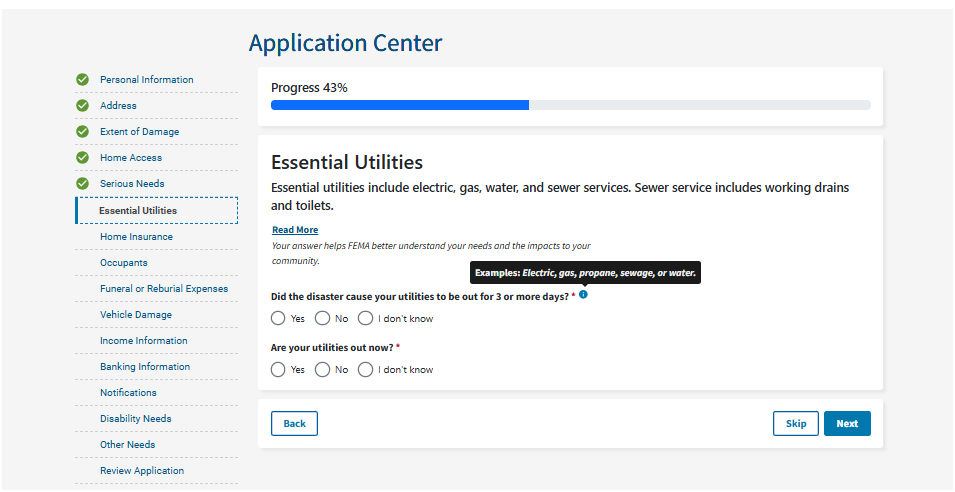
Essential Utilities
Essential utilities include electric, gas, water, and sewer services. Sewer service includes working drains and toilets.
Read More
Your answer helps FEMA better understand your needs and the impacts to your community.
Did the disaster cause your utilities to be out for 3 or more days? *
Yes/No/I don't know
Are your utilities out now? *
Yes/No/I don't know
Renter Insurance screen

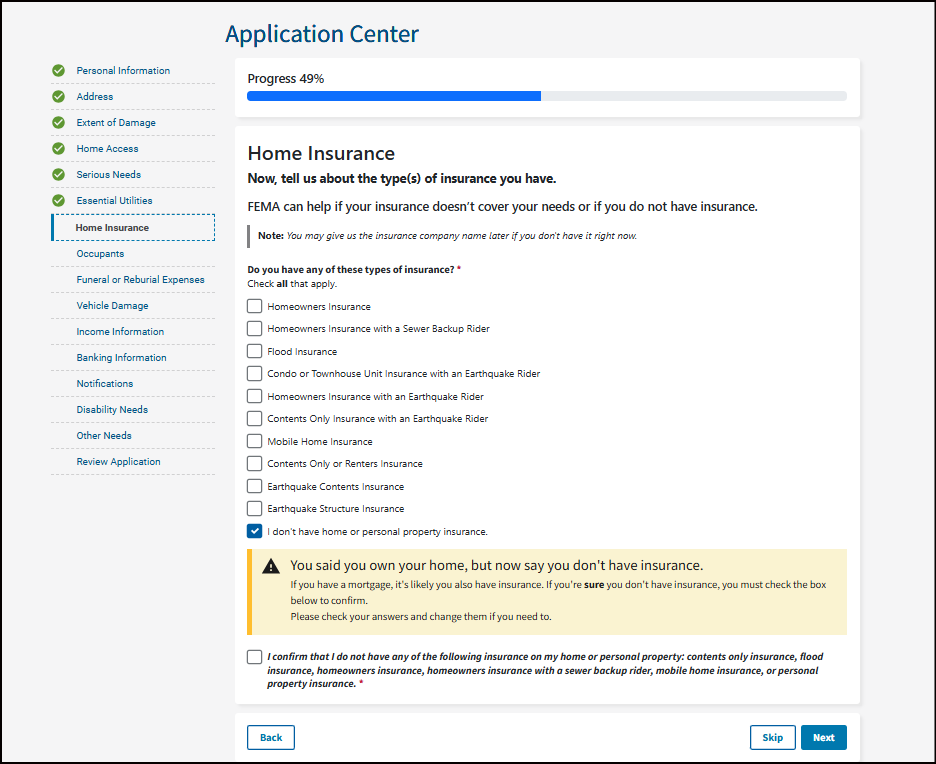
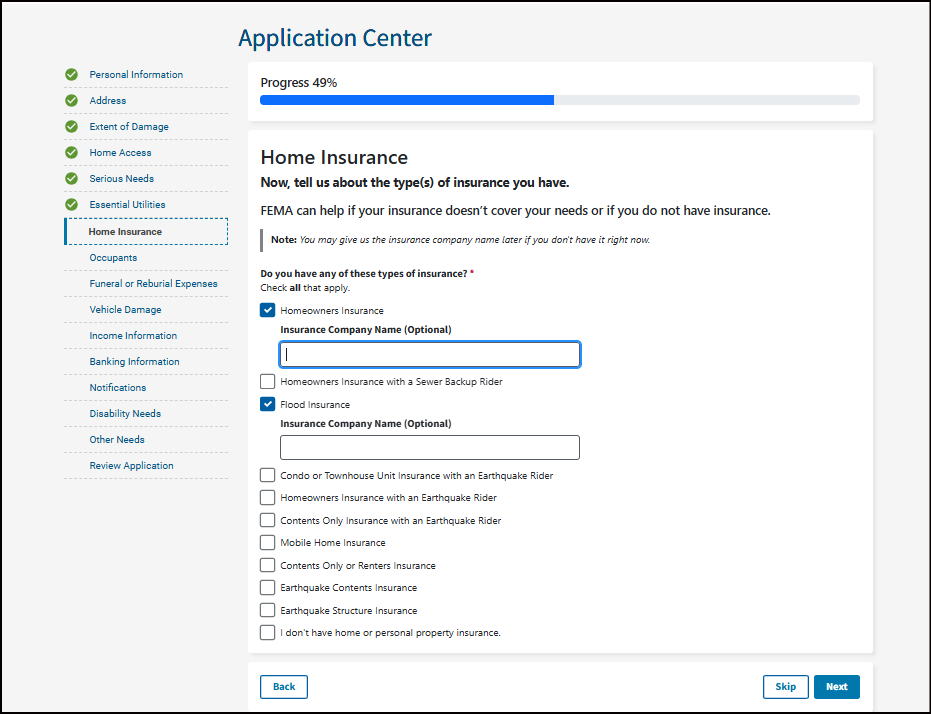
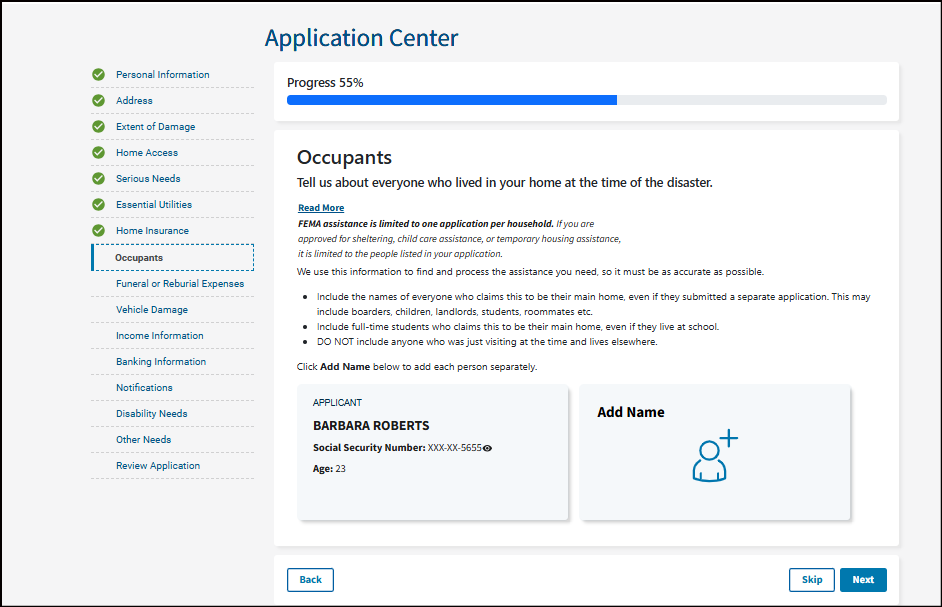

Occupants
Tell us about everyone who lived in your home at the time of the disaster.
Read More
FEMA assistance is limited to one application per household. If you are approved for sheltering, child care assistance, or temporary housing assistance, it is limited to the people listed in your application.
We use this information to find and process the assistance you need, so it must be as accurate as possible.
Include the names of everyone who claims this to be their main home, even if they submitted a separate application. This may include boarders, children, landlords, students, roommates etc.
Include full-time students who claims this to be their main home, even if they live at school.
DO NOT include anyone who was just visiting at the time and lives elsewhere.
Click Add Name below to add each person separately.
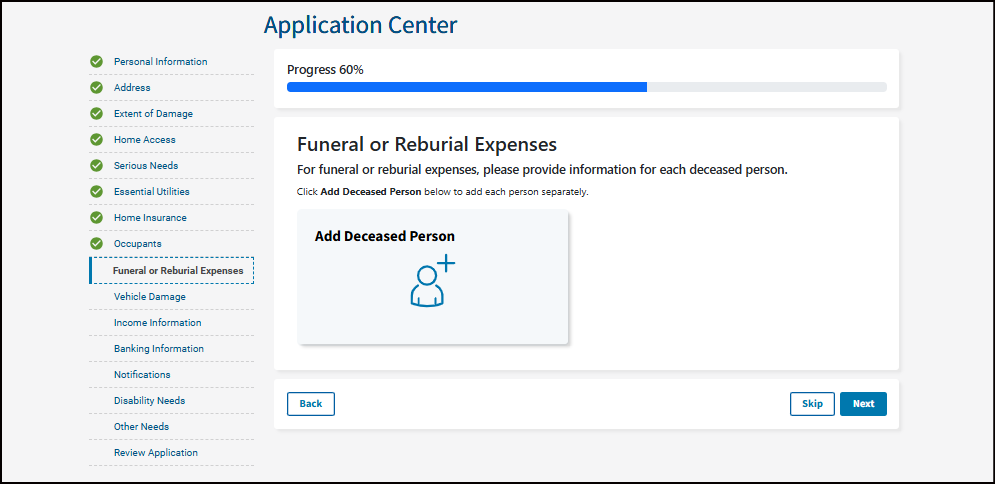
Funeral or Reburial Expenses
For funeral or reburial expenses, please provide information for each deceased person.
Click Add Deceased Person below to add each person separately.
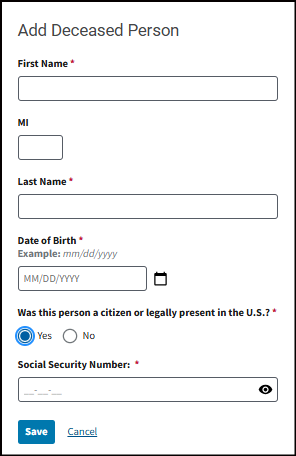

Drivable vehicle screen
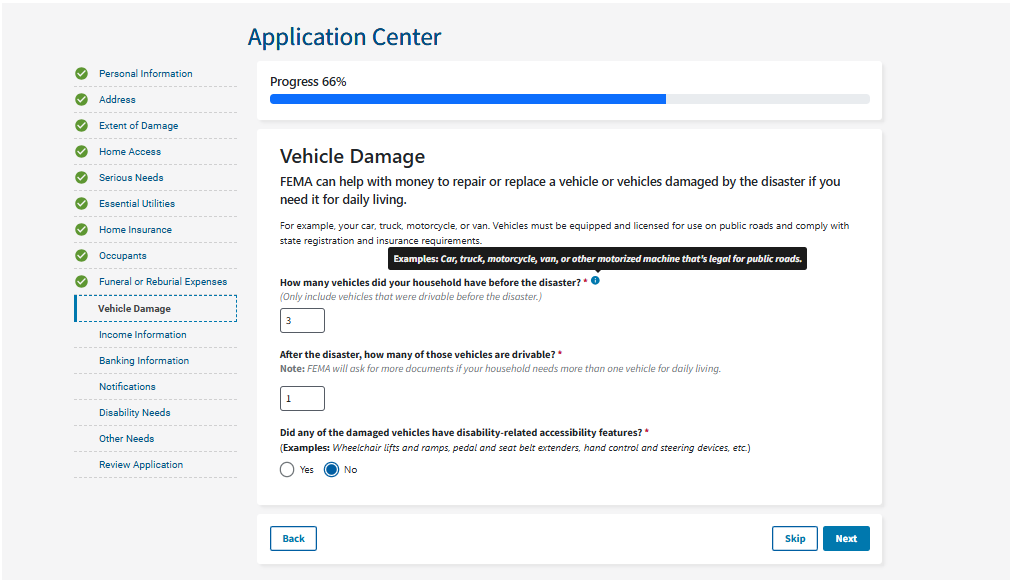
No drivable vehicle
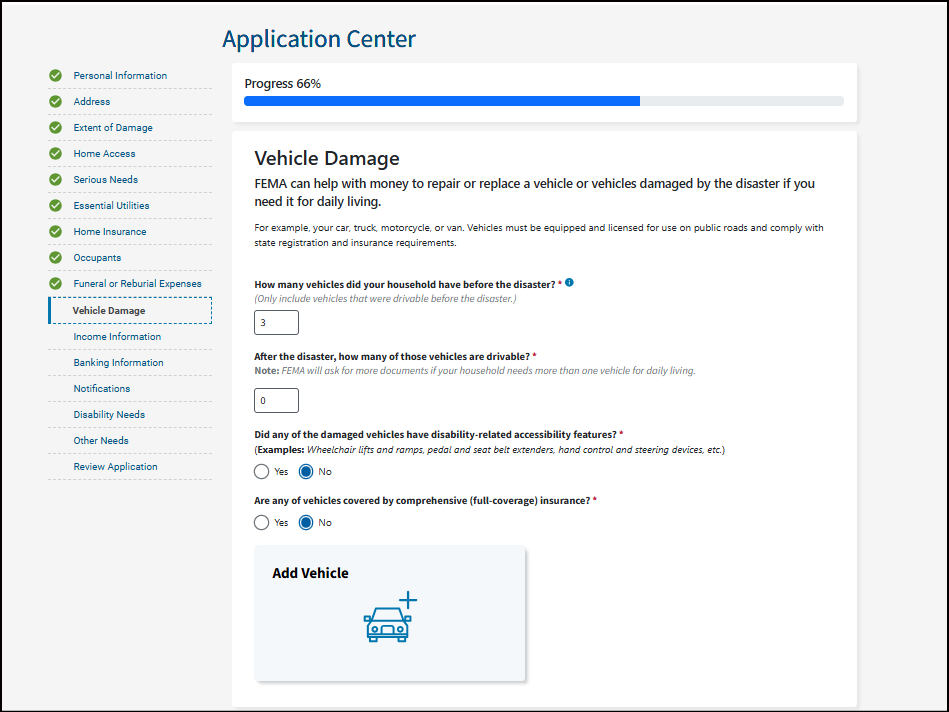

Vehicle Damage
FEMA can help with money to repair or replace a vehicle or vehicles damaged by the disaster if you need it for daily living.
For example, your car, truck, motorcycle, or van. Vehicles must be equipped and licensed for use on public roads and comply with state registration and insurance requirements.
How many vehicles did your household have before the disaster? *
(Only include vehicles that were drivable before the disaster.)
After the disaster, how many of those vehicles are drivable? *
Note: FEMA will ask for more documents if your household needs more than one vehicle for daily living.
Did any of the damaged vehicles have disability-related accessibility features? *
(Examples: Wheelchair lifts and ramps, pedal and seat belt extenders, hand control and steering devices, etc.)
Yes/No
Are any of vehicles covered by comprehensive (full-coverage) insurance? *
Yes/No
Income screen/Pending removal of income question
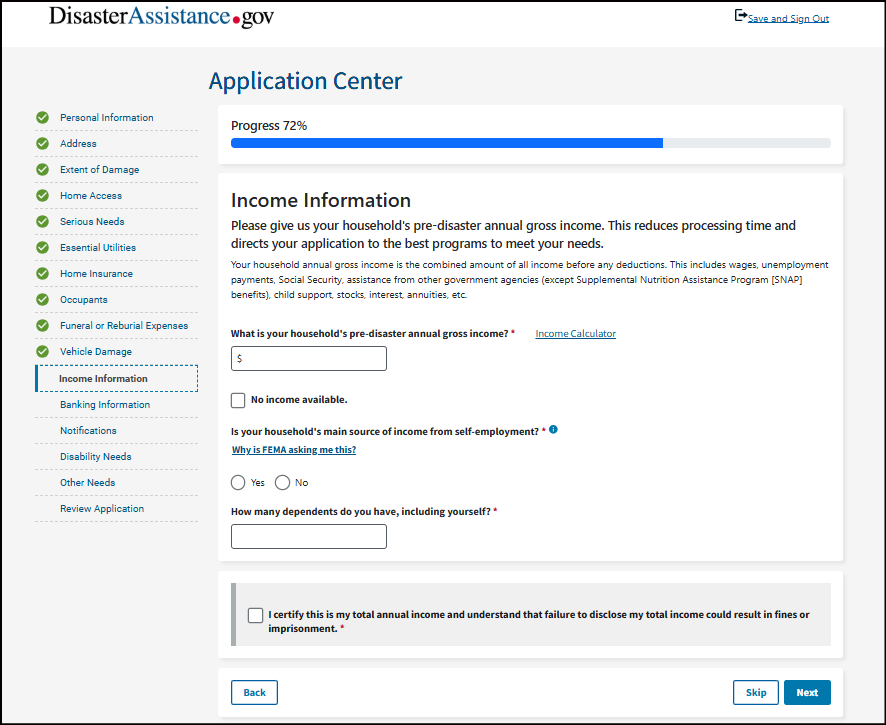
Updated Income Screen/not in use

Income Information
Is your household's main source of income from self-employment? *
Why is FEMA asking me this?
FEMA may be able to provide help with any items you need for your self-employment. Items that were in your home or vehicle and damaged by the disaster. Assistance is limited to self-employed individuals. FEMA can't help with business losses (for example, if you have employees).
Yes/No
How many dependents do you have, including yourself? *
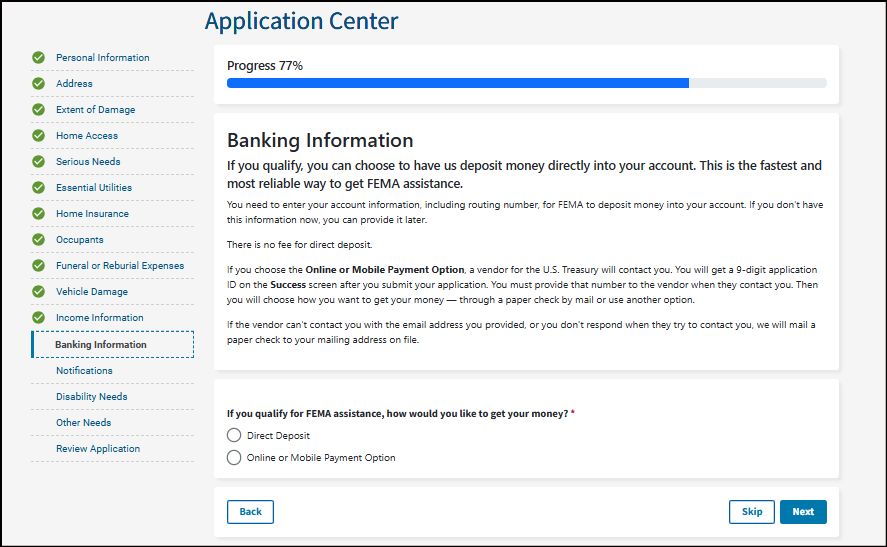
Banking Information
If you qualify, you can choose to have us deposit money directly into your account. This is the fastest and most reliable way to get FEMA assistance.
You need to enter your account information, including routing number, for FEMA to deposit money into your account. If you don't have this information now, you can provide it later.
There is no fee for direct deposit.
If you choose the Online or Mobile Payment Option, a vendor for the U.S. Treasury will contact you. You will get a 9-digit application ID on the Success screen after you submit your application. You must provide that number to the vendor when they contact you. Then you will choose how you want to get your money — through a paper check by mail or use another option.
If the vendor can't contact you with the email address you provided, or you don't respond when they try to contact you, we will mail a paper check to your mailing address on file.

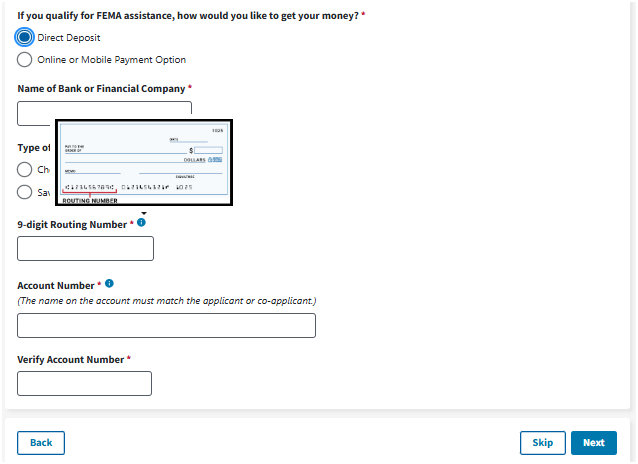

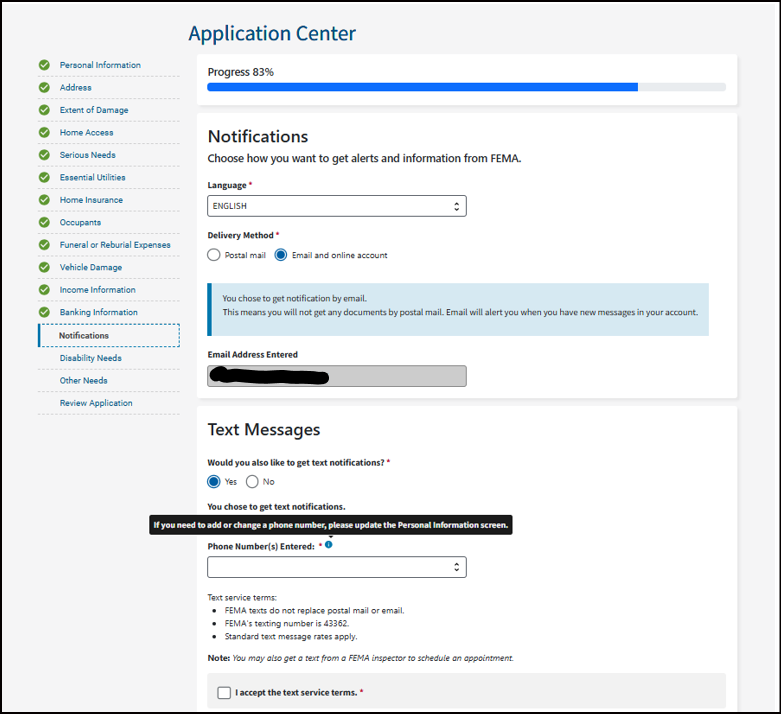



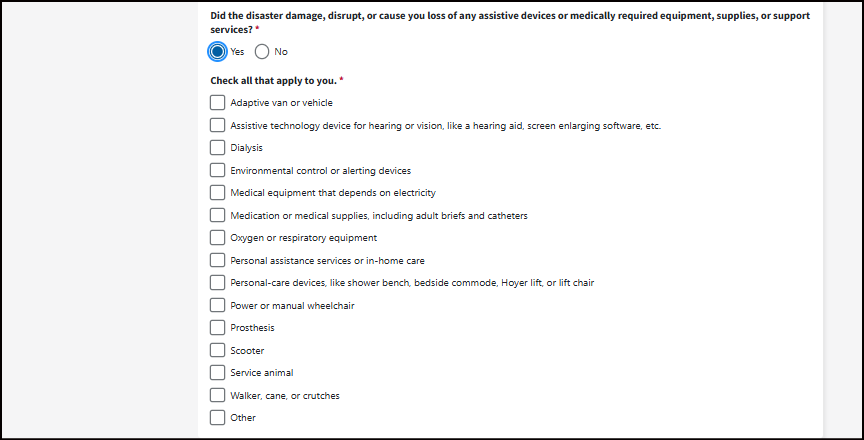
Disability Needs
The Americans with Disabilities Act (ADA) defines disability as "a physical or mental impairment that substantially limits one or more of the major life activities of such individual," 42 USC 12102(2)(A). If this definition applies to you or a someone in your household, check Yes.
If yes, check all disabilities that apply or check Prefer Not to Answer.
Do you or anyone in your household have a disability? *(This includes any condition that affects your ability to perform activities of daily living or requires an assistive device.)
Yes/No
Check all that apply to you. *
Cognitive or developmental disabilities
Hearing or speech
Independent living
Mental health
Mobility
Self-care
Vision
Other
Prefer not to answer.
Did the disaster damage, disrupt, or cause you loss of any assistive devices or medically required equipment, supplies, or support services? *
Yes/No
Check all that apply to you. *
Adaptive van or vehicle
Assistive technology device for hearing or vision, like a hearing aid, screen enlarging software, etc.
Dialysis
Environmental control or alerting devices
Medical equipment that depends on electricity
Medication or medical supplies, including adult briefs and catheters
Oxygen or respiratory equipment
Personal assistance services or in-home care
Personal-care devices, like shower bench, bedside commode, Hoyer lift, or lift chair
Power or manual wheelchair
Prosthesis
Scooter
Service animal
Walker, cane, or crutches
Other
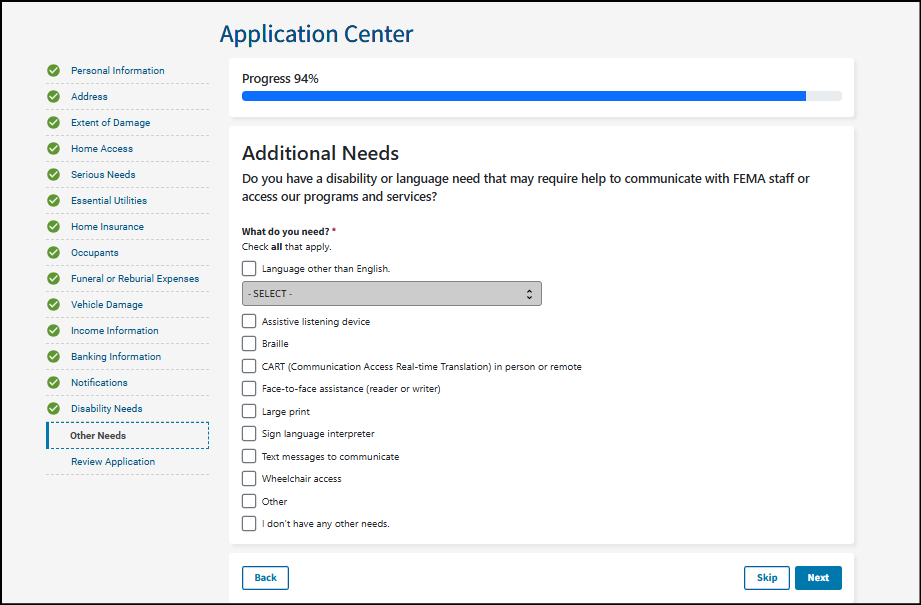
Additional Needs
Do you have a disability or language need that may require help to communicate with FEMA staff or access our programs and services?
What do you need? *Check all that apply.
Language other than English.
- Select –
Acholi/Arabic/Bengali/Cantonese/French/Haitian/Creole/Hindi/Italian/Korean/Laotian/Mandarin/Polish/Portuguese/Russian/Samoan/Spanish/Tagalog/Vietnamese/Other
Assistive listening device
Braille
CART (Communication Access Real-time Translation) in person or remote
Face-to-face assistance (reader or writer)
Large print
Sign language interpreter
Text messages to communicate
Wheelchair access
Other
I don't have any other needs.


Review Your Application
You are about to submit your application to FEMA. Please check all information very carefully. You will only be able to make limited changes after you submit your application.
If you need to make changes, click Edit and go to the screen(s) you need. After you correct and save the information, you will return to this review.
Once everything is correct, click Submit Application.
When I click "Submit," I certify that:
The information I entered on my FEMA application is true and correct to the best of my knowledge.
I understand that FEMA or the state, territory, or tribal authorities may require me to return some or all funds issued to me if any of the following statements are true:
I received funds from insurance or other sources for the same loss.
I did not use FEMA, state, territory, or tribal funds for its intended purpose.
I received the funds in error.
I authorize FEMA to verify all information I entered on my application about my primary home, income, identity, and dependents to determine eligibility for assistance.
I authorize FEMA, state, territory, or tribal authorities to request my personal information from sources like my insurance or financial companies.
Application Details
Disaster Information
You are applying for VA SEVERE STORMS RI-DAIP 10-20-08 BB that occurred 10/20/2008 - Present Time.
Type of Assistance
You are applying for:
Personal property damage
Vehicle damage
New or extra childcare costs
Access to your home
Medical or dental expenses
Lodging expenses
Funeral or reburial expenses
Home Safety Need
Food, clothing, shelter, gas, medication, or medical equipment
Home damage
Loss of Utilities
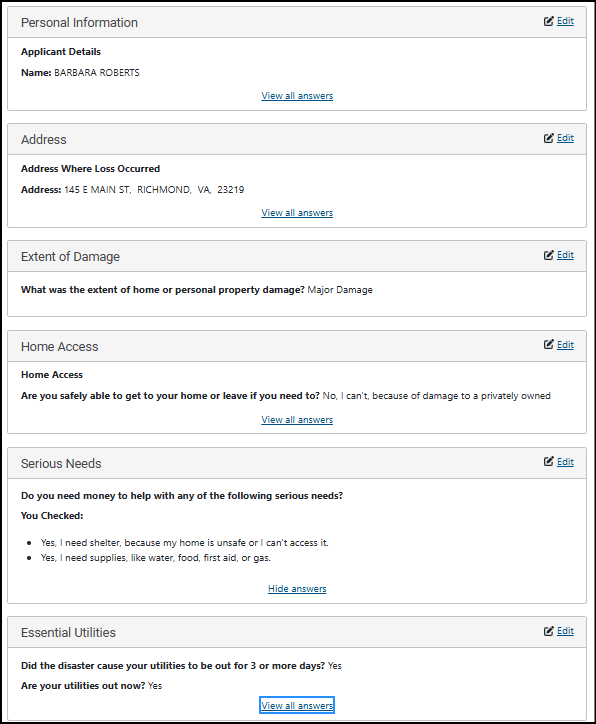
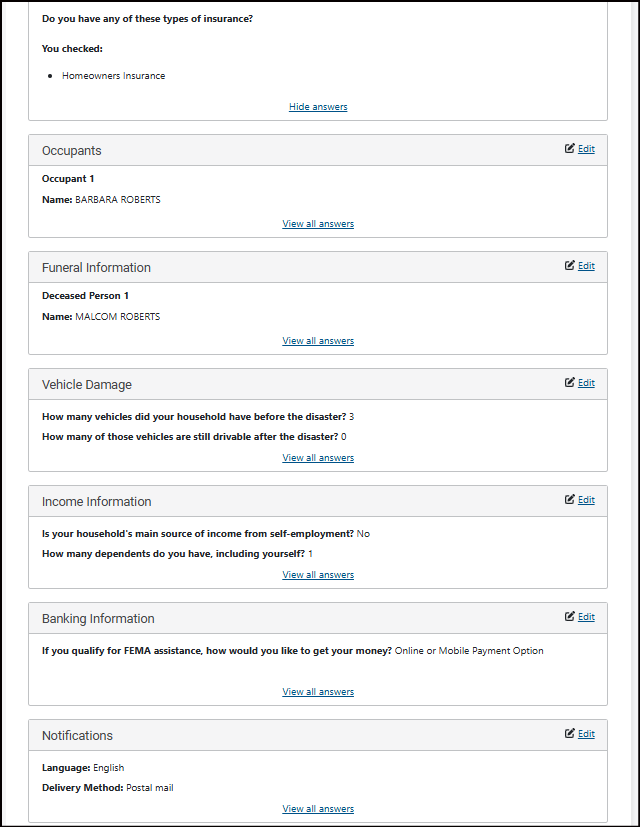
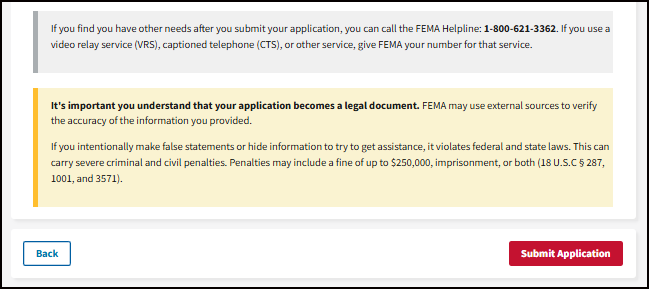
If you find you have other needs after you submit your application, you can call the FEMA Helpline: 1-800-621-3362. If you use a video relay service (VRS), captioned telephone (CTS), or other service, give FEMA your number for that service.
It's important you understand that your application becomes a legal document. FEMA may use external sources to verify the accuracy of the information you provided.
If you intentionally make false statements or hide information to try to get assistance, it violates federal and state laws. This can carry severe criminal and civil penalties. Penalties may include a fine of up to $250,000, imprisonment, or both (18 U.S.C § 287, 1001, and 3571).
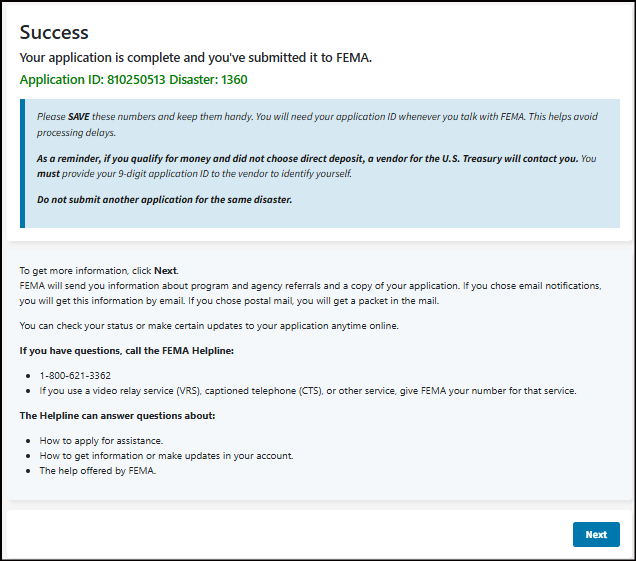
Success
Your application is complete and you've submitted it to FEMA.
Application ID: XXXXXXXXX Disaster: XXXX
Please SAVE these numbers and keep them handy. You will need your application ID whenever you talk with FEMA. This helps avoid processing delays.
As a reminder, if you qualify for money and did not choose direct deposit, a vendor for the U.S. Treasury will contact you. You must provide your 9-digit application ID to the vendor to identify yourself.
Do not submit another application for the same disaster.
To get more information, click Next.
FEMA will send you information about program and agency referrals and a copy of your application. If you chose email notifications, you will get this information by email. If you chose postal mail, you will get a packet in the mail.
You can check your status or make certain updates to your application anytime online.
If you have questions, call the FEMA Helpline:
1-800-621-3362
If you use a video relay service (VRS), captioned telephone (CTS), or other service, give FEMA your number for that service.
The Helpline can answer questions about:
How to apply for assistance.
How to get information or make updates in your account.
The help offered by FEMA.
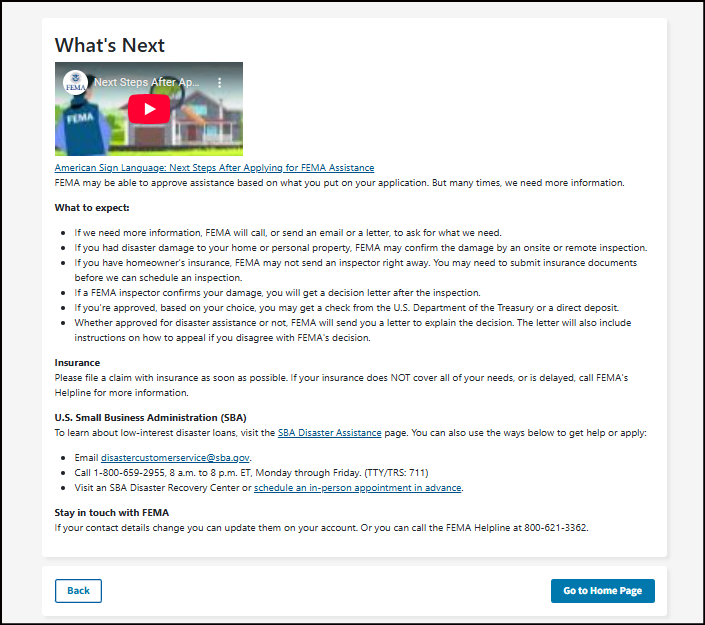
FEMA may be able to approve assistance based on what you put on your application. But many times, we need more information.
What to expect:
If we need more information, FEMA will call, or send an email or a letter, to ask for what we need.
If you had disaster damage to your home or personal property, FEMA may confirm the damage by an onsite or remote inspection.
If you have homeowner's insurance, FEMA may not send an inspector right away. You may need to submit insurance documents before we can schedule an inspection.
If a FEMA inspector confirms your damage, you will get a decision letter after the inspection.
If you're approved, based on your choice, you may get a check from the U.S. Department of the Treasury or a direct deposit.
Whether approved for disaster assistance or not, FEMA will send you a letter to explain the decision. The letter will also include instructions on how to appeal if you disagree with FEMA's decision.
Insurance
Please file a claim with insurance as soon as
possible. If your insurance does NOT cover all of your needs, or is
delayed, call FEMA's Helpline for more information.
U.S. Small Business Administration (SBA)
To learn about
low-interest disaster loans, visit the SBA
Disaster Assistance page. You can also use the ways below to
get help or apply:
Call 1-800-659-2955, 8 a.m. to 8 p.m. ET, Monday through Friday. (TTY/TRS: 711)
Visit an SBA Disaster Recovery Center or schedule an in-person appointment in advance.
Stay in touch with FEMA
If your contact details change
you can update them on your account. Or you can call the FEMA
Helpline at 800-621-3362.
| File Type | application/vnd.openxmlformats-officedocument.wordprocessingml.document |
| Author | Tevalt, Jane |
| File Modified | 0000-00-00 |
| File Created | 2025-09-18 |
© 2025 OMB.report | Privacy Policy
